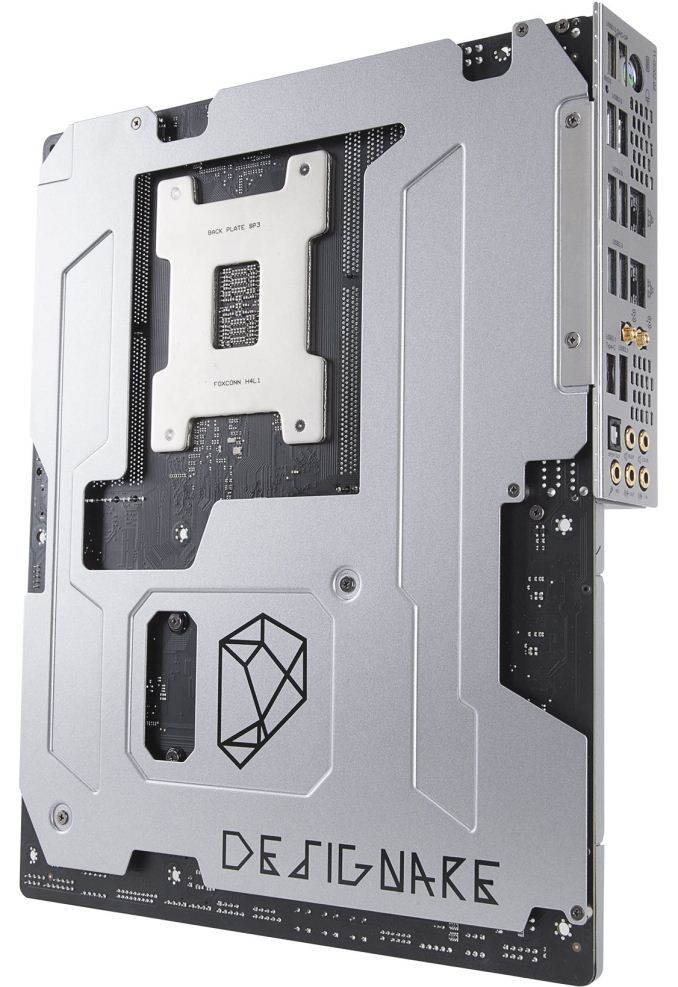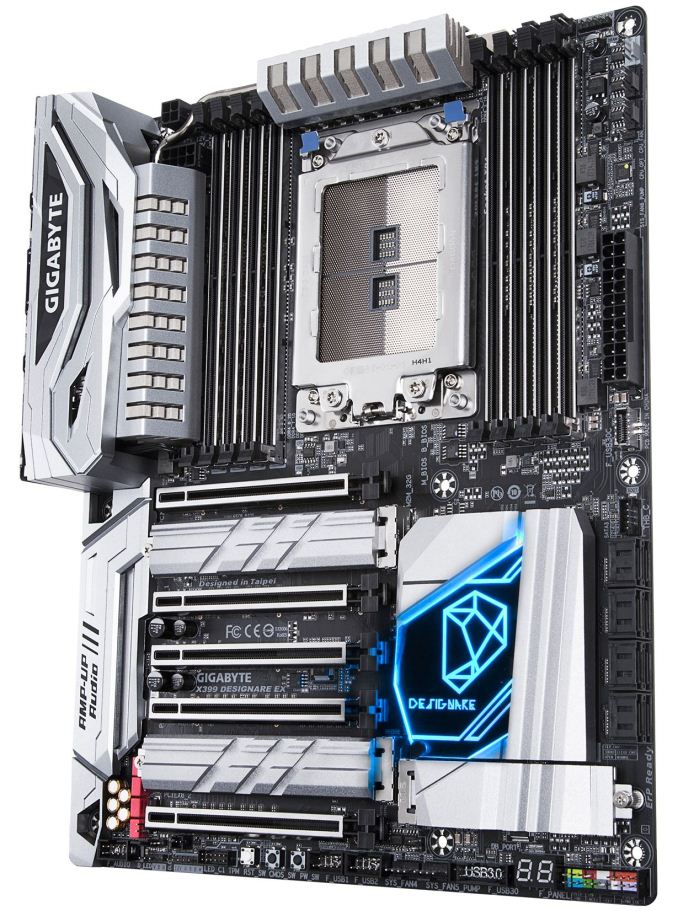An AMD Threadripper X399 Motherboard Overview: A Quick Look at Seven Products
by Ian Cutress & Joe Shields on September 15, 2017 9:00 AM ESTAdded 9/19: GIGABYTE X399 Designare-EX
One of the first things one may notice on this board is lack of RGB LEDs compared with the AORUS Gaming 7. On the Gaming 7, where RGB LEDs are just about everywhere, the Designare EX on the other hand only has a few under the PCH heatsink. Aside from that, design aesthetics are remarkably similar, with only the color scheme changed from black colored heatsinks and shrouds (with the AORUS name) to all silver, and the GIGABYTE name on the shrouds instead. The PCH heatsink is the same shape with a different accent plate for the Designare, marking a not to GIGABYTE's aimed market for this product: design professionals. Also included is an integrated I/O shield giving it a more high-end feel.
Outside of what has been listed above, the specifications for the Designare are very similar to the Gaming 7, as it uses the same base PCB. Keeping on the platform trend, the Designare EX supports quad channel memory at two DIMMs per channel, for eight total supporting up to 128GB. What looks like an 8-phase VRM uses the same style main heatsink connected to a secondary heatsink via a heat pipe located behind the rear I/O. Being the same PCB, the power delivery is also listed as ‘server class’ like the Gaming 7, using fourth generation International Rectifier (IR) PWM controllers and third generation PowIRstage chokes. EPS power is found in its normal location in the top left corner of the board, with one 8-pin and one 4-pin.
In the top right corner of the board are five 4-pin fan headers along with an RGBW header for LEDs. Two other RGB headers are found across the bottom of the board, including another RGBW header. USB connectivity uses an onboard USB 3.1 (10Gbps) header from the chipset close to the eight SATA ports. There is a USB 3.0 header on the bottom of the board, two USB 2.0 headers near the power buttons, and a TPM header at the bottom of the board.
Like the AORUS Gaming 7, the Designare EX supports three M.2 drives. The two locations between the PCIe slots support up to 110mm long drives, while the third below the PCH heatsink can fit up to 80mm drives. All locations come with additional heatsinks to keep the drives underneath cool. The Designare EX uses the three M.2 slots instead of a separate U.2 connector. For other storage, GIGABYTE has equipped the board with eight SATA ports. The 5-pin Thunderbolt 3 header, required for add-in Thunderbolt 3 cards and unique for X399 to this specific GIGABYTE X399 board, is located just above the SATA ports. We are asking GIGABYTE if they plan to bundle a Thunderbolt 3 add-in card with this model, and are awaiting a response.
The rear of the motherboard, like some other designs on the market, uses a rear backplate to assist with motherboard rigidity. The thinking here is that these motherboards are often used in systems with multiple heavy graphics cards or PCIe coprocessors, such that if a motherboard screw is incorrectly tightened, the motherboard might be required to take the load and eventually warp. With the back-plate in place, this is designed to distribute that potential extra torque throughout the PCB, minimising any negative effects.
The PCIe slots are the same as the Gaming 7 also, with four of the five sourcing its lanes directly from the CPU. The slots used for GPUs are double-spaced and support an x16/x8/x16/x8 arrangement. The middle slot supports PCIe 3.0 x4 connection fed from the chipset. The middle slot can be used for additional add-in cards, such as a Thunderbolt 3 card.
Next to the PCIe slots is GIGABYTE’s audio solution, using a Realtek ALC1220 codec and using an EMI shield, PCB separation for the digital and analog audio signals, filter caps (both WIMA and Nichicon), and has headphone hack detection. GIGABYTE also uses DAC-UP, which delivers a more consistent USB power supply for USB connected audio devices.
Rear IO connectivity on the Designare EX is also like the AORUS Gaming 7. The only difference will be the additional Ethernet port as this model uses dual Intel NICs. Because of the USB 3.0 support from the CPU, the rear IO has eight USB ports, in yellow, blue, and white. There are also two USB 3.1 (10 Gbps) ports from the chipset, one USB Type-C. Network connectivity differs here with the Designare EX using two Intel NICs (we imagine some mixture of I219V or I211AT) and does away with the Rivet Networks Killer E2500 found on its little brother. Last, are a set of audio jacks including SPDIF.
Pricing was not listed, however, if it is slated to be the flagship of the X399 lineup, pricing is expected to be a higher than the already released X399 AORUS Gaming 7 at $389.99 on Amazon. GIGABYTE says the Designare EX will be available come Mid-October.
| GIGABYTE X399 Designare EX | |
| Warranty Period | 3 Years |
| Product Page | N/A |
| Price | TBD |
| Size | ATX |
| CPU Interface | TR4 |
| Chipset | AMD X399 |
| Memory Slots (DDR4) | Eight DDR4 Supporting 128GB Quad Channel Support DDR4 3600+ Support for ECC UDIMM (in non-ECC mode) |
| Network Connectivity | 2 x Intel LAN 1 x Intel 2x2 802.11ac |
| Onboard Audio | Realtek ALC1220 |
| PCIe Slots for Graphics (from CPU) |
2 x PCIe 3.0 x16 slots @ x16 2 x PCIe 3.0 x16 slots @ x8 |
| PCIe Slots for Other (from Chipset) |
1 x PCIe 2.0 x16 slots @ x4 |
| Onboard SATA | 8 x Supporting RAID 0/1/10 |
| Onboard SATA Express | None |
| Onboard M.2 | 3 x PCIe 3.0 x4 - NVMe or SATA |
| Onboard U.2 | None |
| USB 3.1 | 1 x Type-C (ASMedia) 1 x Type-A (ASMedia) |
| USB 3.0 | 8 x Back Panel 1 x Header |
| USB 2.0 | 2 x Headers |
| Power Connectors | 1 x 24-pin EATX 1 x 8-pin ATX 12V 1 x 4-pin ATX 12V |
| Fan Headers | 1 x CPU 1 x Watercooling CPU 4 x System Fan headers 2 x System Fan/ Water Pump headers |
| IO Panel | 1 x PS.2 keyboard/mouse port 1 x USB 3.1 Type-C 1 x USB 3.1 Type-A 8 x USB 3.0 2 x RJ-45 LAN Port 1 x Optical S/PDIF out 5 x Audio Jacks Antenna connectors |
Additional News (9/20):
After speaking with GIGABYTE, it seems that Thunderbolt 3 support will perhaps still be in limbo:
Thunderbolt 3 certification requires a few things from the CPU side like graphical output which we haven't been able to do. We expect this will be developed upon through Raven Ridge and possibly get more groundwork down to activate TB3 on the X399 Designare EX.
The header will remain, though TB3 use / full TB3 enablement will be at a later date. It seems like GIGABYTE has taken note that users are interested in TB3 on AMD.




















99 Comments
View All Comments
HStewart - Friday, September 15, 2017 - link
You got to give some credit to AMD clever marketing teams by naming this x399 when Intel has x299 and then calling this the "The Most Advanced Desktop Motherboard in the World"But in reality there is no Thunderbolt 3.0 support and most likely be updated next year or later with PCIe 4.0 support.
Does it support DDR4-4600?
AMD sure likes to play numbers game and not just chipset name - but with number cores - just remember it mostly marketing - yes it still 16 cores - but 16 cores by one manufacturer does not mean 16 cores from completion.
sartwell - Friday, September 15, 2017 - link
Where is the high speed RAM? You cannot get it anywhere.HowardJones - Friday, September 15, 2017 - link
If you're considering the ROG Zenith be aware that it's having tons of problems overclocking CPU and memory. Theres a huge thread on overclock dot net that is filled with people having problems with the bios. There WAS an Asus rep who was trying to help, but he's pretty much disappeared in the last few weeks.tamalero - Sunday, September 17, 2017 - link
Seems like your average typical Asus mainboard.Asus has really huge troubles in their software segment. I still remember they needed like 50 patches to get their high end routers stable. And yet they couldnt get all what they promised in a working condition and even disabled some stuff in later firmwares.
Same with bioses.
I still remember a time where you had to enable the "floppy" connector in a motherboard (even if you had no drive) if you wanted the bios to actually apply the overclocking settings.
mapesdhs - Tuesday, September 19, 2017 - link
A note for those with older ASUS ROG and other ASUS X79 boards, etc.: there's a thread on the ASUS ROG forum site where a guy has provided modded BIOS files to support booting from NVMe devices, aswell as rolling in all the updates to the latest microcode, Intel RAID, etc. Very handy indeed, and he takes requests for other ASUS boards. SSDs like the 950 Pro have their own boot ROM, but a BIOS with boot support is perfect for the 960 EVO/Pro and other models which don't have their own boot ROM.I just bought two R4Es (one basically new), a 4930K, a 16GB/2400 DDR3 kit and a 120mm AIO for a total of 320 UKP. Who needs new stuff? :D My next new build will be TR or EPYC though I'm sure.
satai - Saturday, September 16, 2017 - link
Are any details on X399 AORUS Gaming 7 power delivery solution?The rumor was, that the used only 8 phase, but 8s this true for the final design?
danjw - Saturday, September 16, 2017 - link
The Asus Zenith Extreme claims to support 4-way SLI, but I thought Nvidia didn't support 4x slots for SLI? Am I wrong? Or is this a false claim?DanNeely - Saturday, September 16, 2017 - link
Cynically I'm going to guess that if you use several generation old cards that did support 4 way SLI you could combine all 4 together for an act of supreme WTFery.danjw - Saturday, September 16, 2017 - link
I looked at the manual for the Zenith Extreme. It claims the two that the block diagram of the board in this review indicates are 4x are 8x, with the lowest one on the board being 8x as long as you don't have a U.2 drive connected to the U.2 port. So, it is unclear which is correct the block diagram or the manual.danjw - Sunday, September 17, 2017 - link
Apparently, the block diagram wasn't clear. That last slot is 8x/4x depending on if you have a U.2 drive connected.